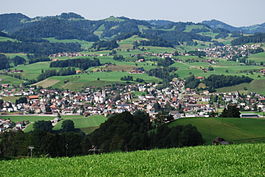|
Bütschwil-Ganterschwil
Bütschwil-Ganterschwil is a municipality in the Wahlkreis (constituency) of Toggenburg in the canton of St. Gallen in Switzerland. On 1 January 2013 the former municipalities of Bütschwil and Ganterschwil merged to form the new municipality of Bütschwil-Ganterschwil.[3] HistoryBütschwil is first mentioned in 779 as Bucinesvilare.[4] Ganterschwil is first mentioned in 779 as Cantrichesuilare.[5] Geography  The former municipalities that now make up Bütschwil-Ganterschwil have a total combined area of 21.83 km2 (8.43 sq mi).[6] Bütschwil had an area, as of 2006[update], of 13.7 km2 (5.3 sq mi). Of this area, 66.3% is used for agricultural purposes, while 19.8% is forested. Of the rest of the land, 12.4% is settled (buildings or roads) and the remainder (1.5%) is non-productive (rivers or lakes).[7] The former municipality is located along the Thur river. On the left bank of the Thur, it consists of the linear villages of Bütschwil and Dietfurt and the hamlets of Grämigen, Tierhag, Feld, Kengelbach and Zwiselen. While on the right bank are the hamlets of Langensteig and Laufen. Ganterschwil had an area, as of 2006[update], of 8.1 km2 (3.1 sq mi). Of this area, 63.8% is used for agricultural purposes, while 26.2% is forested. Of the rest of the land, 7% is settled (buildings or roads) and the remainder (3%) is non-productive (rivers or lakes).[7] The former municipality is located on a high plateau between the Thur and Neckar rivers. It consists of the village of Ganterschwil and the hamlets of Äwil, Anzenwil, Bleiken, Ötschwil and Tobel as well as scattered individual farm houses. DemographicsThe total population of Bütschwil-Ganterschwil (as of December 2020[update]) is 5,041.[8] Historic PopulationThe historical population is given in the following chart:[9]  TransportBütschwil-Ganterschwil sits on the Wil–Ebnat-Kappel line between Wattwil and Wil and is served by the St. Gallen S-Bahn at Bütschwil and Dietfurt. SightsThe village of Bütschwil is designated as part of the Inventory of Swiss Heritage Sites.[10] References
External linksWikimedia Commons has media related to Bütschwil-Ganterschwil.
|
||||||||||||||||||||||||||||||||||||||||||||||||||




